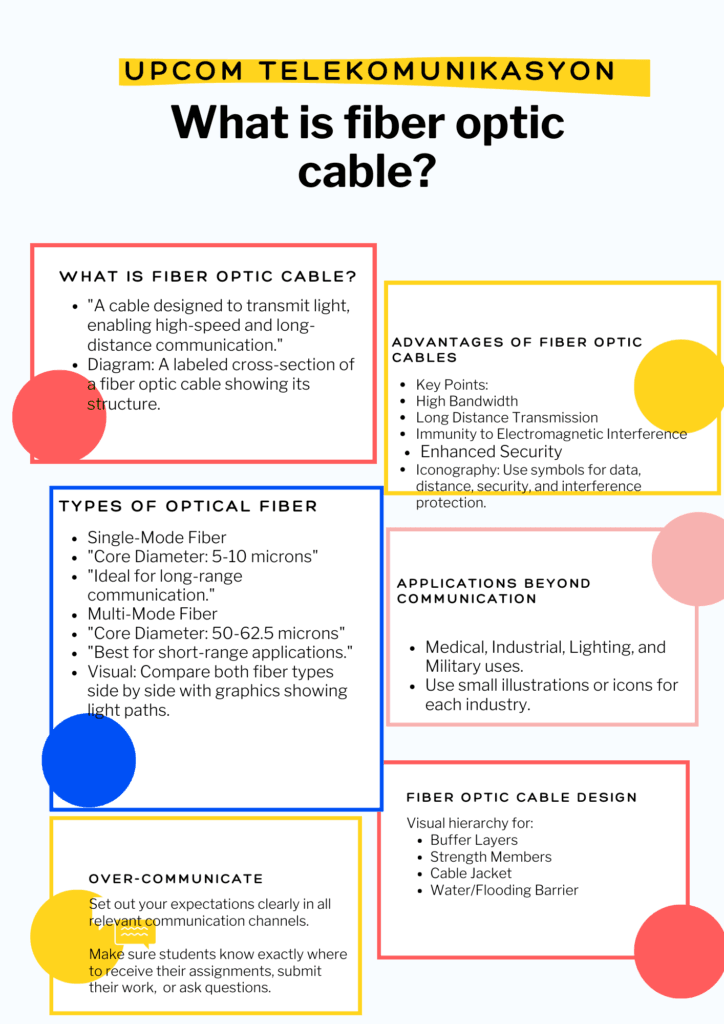09 Ocak What is fiber optic cable
Fiber optic cables are an innovative communication medium that transmit data using light instead of electrical signals. Designed for efficiency and speed, these cables leverage thin strands of glass or plastic fibers bundled within a protective casing. The question; What is fiber optic cable? can be answered succinctly: it is the backbone of modern data transfer, offering unparalleled bandwidth and reliability for applications ranging from internet connectivity to industrial and medical solutions.
The History of Fiber Optic Cables
Fiber optic technology has its roots in the mid-20th century but gained significant commercial adoption in 1977. Explore the detailed history of fiber optics
It marked a transformation in long-distance, high-bandwidth communications, replacing traditional copper cables. The basic structure of a fiber optic cable includes:
- Outer Jacket: Protects against environmental damage.
- Plastic Coverings: Encases and shields bundled fibers.
- Core and Cladding: Core transmits light, while cladding ensures light stays confined.
Advantages of Fiber Optic Cables
- High Bandwidth: Capable of transmitting vast amounts of data.
- Long Distance Transmission: Minimal signal loss over kilometers.
- Immunity to Electromagnetic Interference (EMI): Ideal for environments with high electrical noise.
- Enhanced Security: Difficult to tap into without being detected.
Optik Fiber Nedir?
Optical fiber refers to a flexible, transparent medium made by drawing glass or plastic into thin strands. Each strand is slightly thicker than a human hair and enables the transmission of light signals. Light, confined within the core, carries data in the form of digital pulses.
Key Components:
- Core: Carries the light signals.
- Cladding: Reflects light back into the core.
Coating: Protects against moisture and damage.
Types of Optical Fiber
Single-Mode Fiber
- Core Diameter: 5-10 microns.
- Light Transmission: Light travels in a single path, reducing dispersion.
- Applications: Telecommunications, CATV, and Internet backbones.
- Advantages: High speed and long-range transmission (up to 100 km).
Compare single-mode and multi-mode fibers.
Multi-Mode Fiber
- Core Diameter: Typically 50-62.5 microns.
- Light Transmission: Multiple modes or paths, leading to dispersion.
- Applications: Local Area Networks (LANs), short-distance data links.
- Advantages: Economical for short-range applications.
Applications Beyond Communication
Fiber optics extend their utility into non-telecommunication fields, such as:
- Medical Industry: Endoscopic devices for minimally invasive surgeries.
- Industrial Applications: Fiberscopes for inspecting engines and pipelines.
- Lighting and Decorations: Used in smart lighting and aesthetic designs.
- Military and Aerospace: Secure communication and advanced weapon systems.
Fiber Optik Kablo Tasarımı
Fiber optic cables are tailored to withstand diverse environments. A standard cable consists of the following:
1. Buffer Layers
Protects optical fibers from external forces and stresses. Types include:
- Loose Tube: Rugged and filled with gel for outdoor use.
- Tight Buffer: Compact and suited for indoor applications.
2. Strength Members
Provide tensile strength and enhance durability. Examples:
- Aramid Yarn (Kevlar): Commonly used for its lightweight and robust properties.
- Steel Strands: Adds flexibility and structural integrity.
3. Cable Jacket
The outer jacket ensures the cable withstands environmental challenges. Options include:
- Polyethylene (PE): UV resistant and durable.
- Polyvinyl Chloride (PVC): Flame retardant.
- Low Smoke Zero Halogen (LSZH): Suitable for public areas.
4. Water/Flooding Barrier
Essential for outdoor and underground cables:
- Moisture-Resistant Coatings: Such as silicone rubber.
- Metallic Barriers: Axial aluminum foils block water ingress.
Innovations in Fiber Optics
Fiber optic technology continues to evolve. Key advancements include:
- Wavelength Division Multiplexing (WDM): Enables multiple signals on a single fiber.
- Bend-Insensitive Fibers: Minimizes signal loss in tight installations.
Plastic Optical Fibers (POF): Cost-effective solutions for short-range applications.
What is fiber optic cable?
How to Blow Fiber Optic Cable: A Comprehensive Fiber Jetting Guide
Table of Contents Introduction to fiber optic cable blowingRequired Equipment and ToolsUnderstanding Fiber Blowing Machines and Their ComponentsPreparing for the Fiber Blowing ProcessSafety Precaution...
No comment 0 LikesOptical Fiber
Optik fiber nedir? Bilgiyi çeşitli şekillerde taşıma kavramına alışkınız. Bir tel kablo, konuşmamızdaki sesleri duvardaki bir prize taşır ve başka bir kablo tarafından taşınır...
No comment 8 LikesFTTH installation Technologies
FTTH kurulum teknolojileri İçindekiler FTTH kurulum teknolojilerine yenilikçi yaklaşım...1 Altyapı Paylaşımı...2 Fransa'da kanal paylaşımı...2.1 Kanalizasyon boruları...2.2 Cle...
No comment 1 LikeWhat is MPO Cable
MPO Cables: A Comprehensive Guide to High-Density Fiber Optic Connectivity What is MPO Cable? Executive summary Push On (MPO) Multi-fiber Connectors – Fiber connectors consisting of several opti...
No comment 1 LikeIP55 Outdoor Cabinet
19" IP55 Outdoor Kabinet hakkında yeterli bilgi olmadığını tespit ettik ve bu nedenle bunu araştıracağız. Bu makaleyi okuyorsanız, muhtemelen bir satın alma işlemi yapmayı planlıyorsunuzdur ...
No comment 2 LikesWhat is fiber optic cable
Fiber optic cables are an innovative communication medium that transmit data using light instead of electrical signals. Designed for efficiency and speed, these cables leverage thin strands of glass o...
No comment 3 Likes19″ Rack Cabinet
19" Serbest Daimi Rack Kabinet nedir? 19" serbest duran rack kabinleri sağlam, uygun maliyetli bir muhafaza çözümü sunar. Kabinet 'un hem ön hem de arka tarafında PDU montajı veya bağlantısı. T....
No comment 0 LikesHow Much Does Fiber Optic Cabling Installation Cost?
On average, fiber optic cable installation cost $1 to $6 per 30cm depending on the fiber count. It’s very difficult to estimate an exact price for an entire building to be wired, however an exam...
No comment 4 LikesConstruction Products Regulation (CPR) for Cables
Kablolar için CPR (Yapı Malzemeleri Yönetmeliği) Temmuz 2017'de yasal bir gereklilik haline gelmiştir. Fiber optik kablolar için CPR, binalarda kalıcı kurulum için kullanım amacına sahiptir ve ...
No comment 0 Likes5 Fan Facts About the Fiber Optic Cables
Fiber optik kablolar, veri iletmek için cam veya plastik lifler kullanan bir kablo türüdür. İşte fiber optik kablolar hakkında bazı ilginç gerçekler: Hız: Fiber optik kablolar veri iletme kapasitesine sahiptir...
No comment 4 Likes











